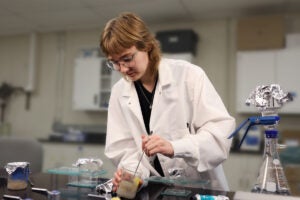Do you know what’s in your medicine cabinet—perhaps some leftover Vicodin from that root canal six months ago? It may be where your teenager is going to get high.
Prescription drug abuse by teens is just one emerging drug trend followed by Dr. Jane Maxwell of The University of Texas at Austin School of Social Work.
“Every year, people find new and often very dangerous ways to get high,” said Maxwell, one of 21 epidemiologists in the country who report substance abuse trends for a work group established by the National Institute on Drug Abuse. “Sometimes our curiosity and innovative natures work against us.”

|
|
A researcher with the School of Social Work, Dr. Jane Maxwell is one of 21 epidemiologists in the country who report substance abuse trends for the National Institute on Drug Abuse.
|
Her job is clear-cut: “Tell me who’s using what drugs, what they look like and what services they need to help quit using.”
Maxwell works the neighborhoods, looks at school surveys, emergency room visits, treatment center records, poison control center statistics and death certificates—all the while searching for other data sources.
“Abuse is up and deaths are up,” she said. “The national trends are worrisome. We need more prevention, intervention and treatment services.”
Epidemiologists study the origins, spread and control of diseases, in a public health model. In the field of substance abuse, they track changes in patterns of drug use, including the incidence and prevalence of the use of specific drugs, characteristics of users and emerging trends.
Members of the Community Epidemiology Work Group meet twice a year to discuss their findings. Reports serve as a resource for human service agencies trying to figure out what new substance abuse problems are emerging and what services are needed.
“We try and stay ahead of the curve when it comes to identifying trends such as the surge in abuse of prescription drugs, emergence of various club drugs and the increase in methamphetamine use across the United States,” said Maxwell. “It’s like trying to do a jigsaw puzzle when the pieces don’t quite fit—but luckily they come close enough together where we can identify some trends.”
In addition to intentional abuse of prescription drugs by teens, researchers have found that:
- Use of heroin by youths and young adults has increased, as shown in the rise of “cheese heroin” (a mixture of Tylenol PM and heroin) in Dallas.
- Methamphetamine has spread from the Pacific Coast eastward.
- Abuse of the tranquilizer Xanax and the muscle relaxant Soma has increased.
- Use of Ecstasy has increased as the drug spreads from the club scene to the street.
- Crack cocaine users are now more likely to be white or Hispanic than African American.
- Alcohol and cocaine are the primary drugs for which Texans enter treatment.

Experts don’t know exactly why the non-medical use of prescription drugs is increasing among teens, said Maxwell. According to the national household survey, abuse of prescription pain relievers is second only to marijuana use.
The availability of drugs is probably one reason. Doctors are prescribing more drugs for more health problems and online pharmacies make it easy to get prescription drugs without a prescription, even for teenagers. Vicodin, OxyContin and Xanax are among the drugs that are most likely to be abused.
“The primary reasons for abusing prescription pain relievers is their widespread availability and easy access,” said Maxwell.
Many teens also believe they are safer than street drugs, that painkillers are not addictive and that there is less shame attached to using them as compared to using drugs like heroin or cocaine.
Codeine cough syrup is commonly abused and Coricidin HBP, which is known as “Triple C’s” or “Skittles,” is popular, especially among youth. (Coricidin HBP looks like the candy Skittles.)
Individuals ages 19-25 have the highest rates of lifetime use of these drugs and the rates are increasing, according to trends. The use of OxyContin by 12th graders and young adults has increased significantly since 2002, said Maxwell. At the same time, fewer teenagers in 2005 thought there was great risk in using these drugs, as compared to 2004.
In 2005, there were more than 1.4 million emergency room visits associated with drug misuse or abuse and nearly 400,000 involved non-medical use of pharmaceuticals.
“These visits typically involved multiple drugs,” said Maxwell.
In a 2005 analysis of 1,898 death certificates from across Texas, 128 involved a combination of Xanax and another drug.
| Top Tips: A Prescription for Parents
The drugs of choice among teens are no longer street drugs like marijuana, cocaine or LSD. While some teens still use these drugs, many more abuse drugs that don’t carry the same stigma and are easier to get—prescription and over-the-counter drugs. These drugs can be just as addictive and dangerous as illegal drugs. The National Youth Anti-Drug Media Campaign, which is funded by the White House Office of National Drug Control Policy, has several tips for parents on preventing prescription and over-the-counter drug abuse among teens. First and foremost is to education yourself and your teen about the risks of misusing prescription drugs. Advice includes keeping track of quantities of pills, making sure your friends and relatives regularly monitor what is in their own medicine cabinets, discarding old or unused medications and other tips. For more information visit A Prescription for Parents on Preventing Prescription and Over-the Counter Abuse Among Teens (PDF) or visit Parents. The Anti-Drug. |
The mixing of prescription drugs and alcohol usually “to get high” also has deadly consequences, Maxwell said. There have been reports of teenagers and young adults mixing Xanax with cola drinks to make them feel very drunk and that others are taking Vicodin before they start drinking to get drunker faster. These drugs are often seen in fatal traffic accident reports.
Prior to joining the School of Social Work faculty, Maxwell was chief of research at the Texas Commission on Alcohol and Drug Abuse. Her research group was recognized as a leader nationally in substance abuse surveys, collection of primary and secondary data related to substance abuse and the monitoring of drug trends and patterns in Texas, in the U.S. and internationally.
“Because of the Internet, new drug trends move around the world quickly,” she said.
Most recently, Maxwell was the recipient of a Fulbright Senior Scholar award to provide consultation on the development of a study of methamphetamine use by long-distance truck drivers in Australia.
She also collaborates with other School of Social Work faculty at the Addiction Research Institute (ARI) of the Center for Social Work Research at the university. The ARI has a number of evaluation, research and training projects funded by the National Institute on Drug Abuse of the National Institutes of Health, federal Substance Abuse and Mental Health Services Administration and the Texas Department of State Health Services.
“The institute is dedicated to improving access and quality of services for underserved populations with substance use and related disorders,” said Director Richard Spence. “We look at individual, family, societal and cultural levels that influence substance abuse and substance abuse treatment.”
Spence said it is important to consider treatments that are backed by strong research evidence of effectiveness. He recently received a $3 million federal grant from the Substance Abuse and Mental Health Services Administration to study and promote adoption of evidence-based practices in substance abuse treatment.
“The challenge for individuals and families is the work of recovery, which often extends throughout life,” he said. “Treatment is only a temporary service, which helps many persons afflicted by addictions to get started in recovery or to resume their recovery.

|
|
Dr. Richard Spence is director of the Addiction Research Institute of the Center for Social Work Research at the university. He and other researchers look at individual, family, societal and cultural levels that influence substance abuse and substance abuse treatment.
|
“The crucial tasks of recovery occur in addition to treatment and often involve the support of families and peers in a network such as Alcoholics Anonymous or similar groups.”
Maxwell and Spence recently completed a study on the emerging drug trend of heroin inhalation or “snorting” as opposed to injecting heroin. Increased numbers of heroin inhalers have entered treatment in recent years and compared to injectors, these patients enter treatment after a shorter period of heroin use.
Spence and Dr. Lynn Wallisch also have completed a study of border drug problems and treatment utilization, and Dr. Lori Mangrum of the ARI recently spoke at a conference on “Compassion in Action” at the White House.
“More research is needed for preventive strategies to help parents and teens reduce their risk for becoming involved in alcohol and other drugs at an early age,” Maxwell said. “Parents need to talk with their teenage children in opposition to use of illicit drugs and underage use of legal drugs. These kinds of conversations may not be easy or comfortable, but they are important.”
In addition, parents and educators should help debunk the recurring mythology that some drugs are safe because they are popular or “legal,” said Maxwell.
“Pharmaceuticals are not safe just because their production is regulated,” Maxwell said. “Cheese heroin is not safe just because it is not injected. Ecstasy is not safe just because it is widely used in certain party scenes. Alcohol and tobacco are not safe just because it is legal for adults to use them.”
By Nancy Neff
Photos: Christina Murrey



